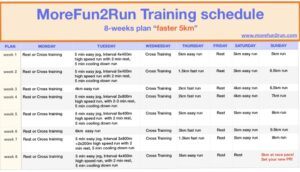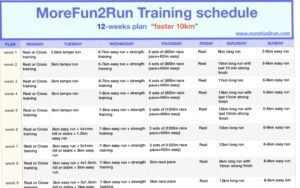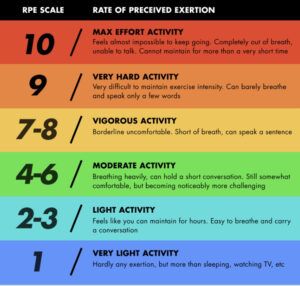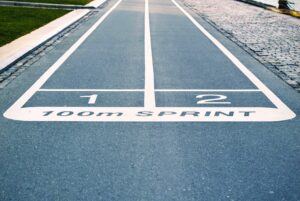You’ve been running some steady 5km or 10km runs for a while, and now you’d like to run that distance faster? Follow one of the MOREFUN2RUN training schedules to develop more power for a higher pace. Run a Faster 5K or Faster 10K and set a new personal record!
Push past a Performance Plateau
 After you’ve been running the same mileage for a while, you may hit a plateau where the performance just doesn’t seem to improve, no matter how hard you try. This doesn’t mean you should train harder, more often, or run faster and further. What you need is a training plan with a variety of distances and different types of training. This will help you to be able to push past the plateau and reach new goals.
After you’ve been running the same mileage for a while, you may hit a plateau where the performance just doesn’t seem to improve, no matter how hard you try. This doesn’t mean you should train harder, more often, or run faster and further. What you need is a training plan with a variety of distances and different types of training. This will help you to be able to push past the plateau and reach new goals.
Variation in training is key
 The best way to improve your performance is a training plan with weekly modifications of training variables, such as interval sessions, and longer runs at different intensity levels, speed, and distances. How often you run per week, the duration of each training, rest days, and the strengthening and flexibility exercises that you do will all have an impact on your progress.
The best way to improve your performance is a training plan with weekly modifications of training variables, such as interval sessions, and longer runs at different intensity levels, speed, and distances. How often you run per week, the duration of each training, rest days, and the strengthening and flexibility exercises that you do will all have an impact on your progress.
Faster 5K and 10K Training Schedules
The MoreFun2Run faster 5km or 10km training plans will guide you to build strength and improve pace. It will get your body ready to run the distance faster than your current personal record. A gradual approach is recommendable to prevent injuries.
GET IT HERE >> MOREFUN2RUN Faster 5km training schedule <<
 This is an eight-week training program for runners who are stuck at a 5K (3.1 miles)plateau, who would like to improve their time. 5km is often an overlooked race distance. But it requires a lot of strength and it can be tough emotionally, mentally, and physically. The whole distance you’ll run at a fast speed!
This is an eight-week training program for runners who are stuck at a 5K (3.1 miles)plateau, who would like to improve their time. 5km is often an overlooked race distance. But it requires a lot of strength and it can be tough emotionally, mentally, and physically. The whole distance you’ll run at a fast speed!
GET IT HERE >>MOREFUN2RUN Faster 10km training schedule<<

This is a twelve-week training program for runners who are stuck at a 10K (6.2 miles) plateau, who would like to improve their time. The training sessions contain several longer runs to build confidence to cover the distance. The schedule also contains tempo and speed sessions to increase your pace.
Different workout levels
You will be training at different speeds and varying intensity levels: walking, long runs, easy run, tempo run, and intervals. But what is the difference?
The intensity of a workout can be described best by a 1-10 effort scale, whereas 1 is standing still and 10 is a full sprint. Using a Relative Perceived Exertion (RPE) scale may give you a better idea of how fast you should try to run during the several training sessions.

To learn how to run a faster 5K or 10K it is important to recognize the different workout intensity levels and incorporate them into the training schedule:

- Easy runs for foundation and recovery (RPE scale 5-6): You‘ll have to run slow (light pace), to become a faster runner. This may sound weird, but slow runs prepare your body for the more intensive running sessions. And they will allow your legs to recover from strong and hard efforts on the other training days. Breathing should be comfortable during an easy run, and at a conversational level. Your heart rate will be steady and under control. You should be able to enjoy running without feeling tired.
- Long runs to increase distance and build up endurance (RPE scale 6-7): Long runs are usually steady moderate runs. These runs should be slightly more challenging than the easy runs. You should still be able to hold a conversation, but you’ll find it difficult to talk in longer sentences. The long-run pace will improve over time and will develop into your “race pace” at the end of the training schedule.
- Tempo-runs to improve that pace (RPE scale 8): A constant up-speed running is sometimes referred to as tempo running. This will improve your running pace. Try to keep up at a constant speed that feels ‘comfortably hard’ for at least 15-20 minutes.

- Interval training to build your fitness, muscular strength, and speed (RPE scale 9): Interval training involves very fast runs over a set distance or time. You will get breathless as you’ll be running faster than during a 5k race. Using a treadmill or running track, and/or a GPS runners watch may help you measure the distances right.
- Non-Running / Cross-training to make yourself stronger and more flexible and to prevent injuries. One “non-running” workout per week is already sufficient to keep up your fitness, but without too much strain on the muscles that you use for running. Cross-training, swimming, cycling, strength training, and/or flexibility workouts or yoga are all good “non-running” workouts to support your running program.
Planning
 The faster 5K plan covers eight weeks, and the faster 10K plan covers twelve weeks in total. Both include 3-4 times of running per week. Always perform a warming up first and a cooling down, and stretches afterward. For the best results try to add at least one cross-training per week and some strengthening exercises. For more flexibility and stability you may add yoga.
The faster 5K plan covers eight weeks, and the faster 10K plan covers twelve weeks in total. Both include 3-4 times of running per week. Always perform a warming up first and a cooling down, and stretches afterward. For the best results try to add at least one cross-training per week and some strengthening exercises. For more flexibility and stability you may add yoga.
Gradual progress
 Sufficient rest, a healthy diet and good hydration, together with a healthy BMI and not too much stress, will all contribute to your running progress. Gradually you’ll become stronger and better. At the end of each training schedule, you’ll be able to run a faster 5km or 10km.
Sufficient rest, a healthy diet and good hydration, together with a healthy BMI and not too much stress, will all contribute to your running progress. Gradually you’ll become stronger and better. At the end of each training schedule, you’ll be able to run a faster 5km or 10km.
Official race event or on your own?
 Of course, you don’t need an official race to set a new PR. You can time the running distance whenever you are ready for it and on any day of the week if you like. But an official race or an organized (park/fun) running event might stimulate you to set an even faster record time. The atmosphere of the event, the cheering crowd, and the energy of all the participants are very motivating to push yourself a bit harder.
Of course, you don’t need an official race to set a new PR. You can time the running distance whenever you are ready for it and on any day of the week if you like. But an official race or an organized (park/fun) running event might stimulate you to set an even faster record time. The atmosphere of the event, the cheering crowd, and the energy of all the participants are very motivating to push yourself a bit harder.
Tips for best results
To perform at your best during a 5km or 10km run, you may find the following tips useful:

- Plan when you will run that Personal Record (PR).
- Plan where you will start and finish, know that running route, know what to expect along the way.
- Emotionally prepare yourself to perform at that best: Yes, I can attitude!
- Go to bed early the night before.
- Have all runners wear and items you need for that run ready to go: GPS watch (charged), water bottle, running belt, shoes, socks, runners wear, sunscreen, cap, sunglasses, etc.
![]()
- Take care of hydration and a healthy, light meal.
- Use the toilet before the start.
- Do your warming up and stretches.
- Your GPS watch ready in the right settings.
- All 5k runners: read, set, GO! Good luck!
- All 10k runners: start the first kilometers a bit slower than our best pace, and speed-up in the second 5km. GO! Good luck!
Celebrate success
 Please share your experiences with us! Let us know how the MoreFun2Run training schedule for a Faster 5km or a Faster 10km has helped you achieve a new personal record. CONGRATULATIONS!
Please share your experiences with us! Let us know how the MoreFun2Run training schedule for a Faster 5km or a Faster 10km has helped you achieve a new personal record. CONGRATULATIONS!
 Now it’s time to celebrate and reward your achievement. An official race might give you a medal, but when you ran on your own, you will need to reward yourself for reaching your goal. Maybe you could book a relaxing sports massage, or get yourself new runners shoes or wear.
Now it’s time to celebrate and reward your achievement. An official race might give you a medal, but when you ran on your own, you will need to reward yourself for reaching your goal. Maybe you could book a relaxing sports massage, or get yourself new runners shoes or wear.
Rest & Active Recovery
 Your body needs to recover after a period of intense running. And it needs to recharge for the next level of training. After you’ve finished the training program, it is recommendable to schedule a full week of non-running. Active recovery means you could go for an easy walk or swim, take a yoga class, or do an easy gym workout. After this week of rest and recovery, you can decide on your next running goal. A longer distance?
Your body needs to recover after a period of intense running. And it needs to recharge for the next level of training. After you’ve finished the training program, it is recommendable to schedule a full week of non-running. Active recovery means you could go for an easy walk or swim, take a yoga class, or do an easy gym workout. After this week of rest and recovery, you can decide on your next running goal. A longer distance?
Hopefully, this article has answered your questions on how to run a faster 5K or 10K and made you set a new PR. If you’d like to share these tips and training plans with other runners among your contacts, simply hit the social media buttons. Thank you! Should you have any questions or remarks, feel free to send me an e-mail at an*******@mo*********.com or leave that comment below and I will get back to you.





Hello, very great post here, I’m not the best in sport but I like to read on the subjet. Good information you have here on workout. I’m more the type of rest and Active recovery!!!
thank you for this information
Lyne
Thank you! I like the rest (and recovery ) AFTER a good workout even better. Maybe you should give it a try, check out the article I posted earlier this year on how to start running from zero to 5km! . You might learn to love running? Anyway, thank yu for the read and your comment!
I am still working on 1 mile as I am new to running, but I am glad there is some help after getting to 5k. I never used to like to exercise much less run but I ve gotten to that point where exercise is finally fun! This helps enormously! Thanks!
Hi Brianna, thanks for your comment. I’m happy the 0-5K training schedule was helpful to you. Maybe you are ready for the next step yet? Check out this article about increasing your mileage to 10km. Good luck!